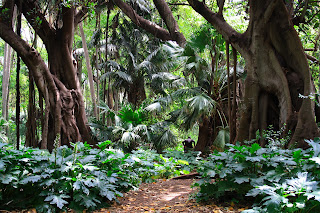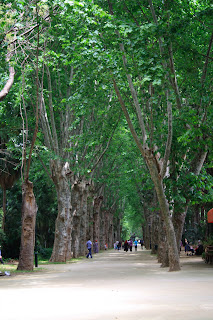The Jardin d'essai is conveniently located right at the Jardin d'essai Metro stop, about three miles east of Le Grande Poste. Jardin d'essai translates literally as "Test Garden," and was originally developed by the French in 1832 as a test garden so they could experiment with crops that they might be able to grow in their newly (1830) acquired colonial territory. It was expanded from the original five acres, but even now is not extremely large.
A few notes on the flora. First of all, it is continually amazing to me how many similar plants we see around the Mediterranean that remind us of plants we had in Jackson, Mississippi, or at least in our Belhaven neighborhood. Today I saw fatsia, oleander, nandina, and other things. Some of the things we grow in Jackson as either indoor plants or annuals, such as poinsettia, mandevilla, bouganvilla, do not have the annual hard freeze to contend with, so they are quite large. And speaking of quite large, the ficus trees in the Gardens are truly amazing.
These trees are cousins to our American Sycamore. They are Plane trees, and they get huge.
These are ficus trees.
I don't know what kind of trees these are, but I love the tuft of leaves on top and the bare branches below.
Would one of my Arab scholar friends please tell me if this says "don't pick the flowers" or "Keep off the grass"? The Bay at the end of the walk, although a highway now runs along the beach.
The Museum of Fine Arts is the building at the end of the garden. The very tall edifice at the top-right is the Memorial du Martyr, those killed during the Algerian war of independence from France, which ended in 1962.
A very large ficus tree -- I think they keep the roots trimmed off before they can be established in the ground. Some of the very old trees of this type can cover acres, I discovered when I Googled it -- I thought they were called banyan trees, but they're the same thing.
From the park entrance down to the Bay. This will be worth the trip during the summer. There is a restaurant in the middle of the garden where we ate lunch. Very nice sitting outside under the trees.
A few notes on the flora. First of all, it is continually amazing to me how many similar plants we see around the Mediterranean that remind us of plants we had in Jackson, Mississippi, or at least in our Belhaven neighborhood. Today I saw fatsia, oleander, nandina, and other things. Some of the things we grow in Jackson as either indoor plants or annuals, such as poinsettia, mandevilla, bouganvilla, do not have the annual hard freeze to contend with, so they are quite large. And speaking of quite large, the ficus trees in the Gardens are truly amazing.
These trees are cousins to our American Sycamore. They are Plane trees, and they get huge.
These are ficus trees.
I don't know what kind of trees these are, but I love the tuft of leaves on top and the bare branches below.
Would one of my Arab scholar friends please tell me if this says "don't pick the flowers" or "Keep off the grass"? The Bay at the end of the walk, although a highway now runs along the beach.
The Museum of Fine Arts is the building at the end of the garden. The very tall edifice at the top-right is the Memorial du Martyr, those killed during the Algerian war of independence from France, which ended in 1962.
A very large ficus tree -- I think they keep the roots trimmed off before they can be established in the ground. Some of the very old trees of this type can cover acres, I discovered when I Googled it -- I thought they were called banyan trees, but they're the same thing.
From the park entrance down to the Bay. This will be worth the trip during the summer. There is a restaurant in the middle of the garden where we ate lunch. Very nice sitting outside under the trees.
















No comments:
Post a Comment